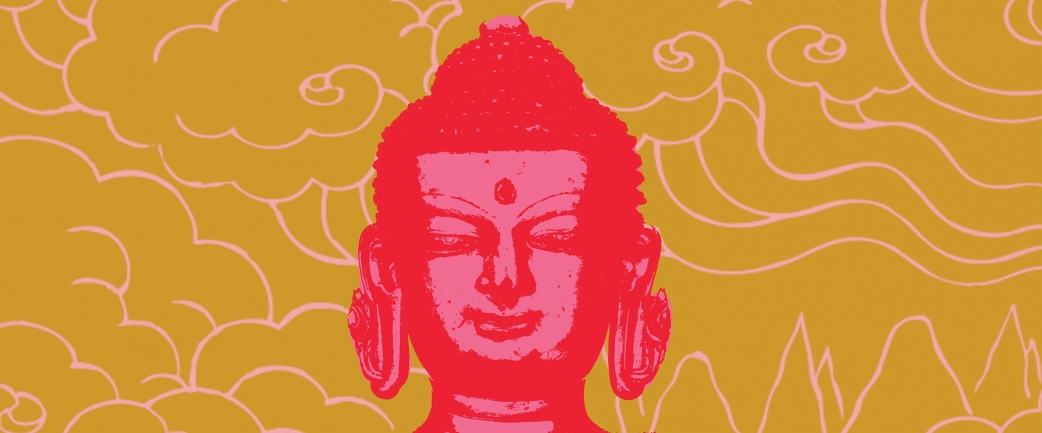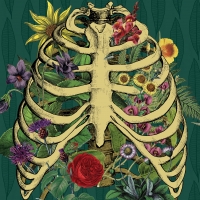
Can technology help us on our spiritual quest, or are we just phoning it in?
It’s Monday, September 23, the first day of fall. Still no chill in the air, but leaves are starting to turn—slightly. In my front yard in Washington DC, the satisfying crunch of walking on fallen leaves has begun. Since we’re in the season of dying—albeit kind of beautifully—I decide today is a good day to download an app that reminds me I’m a part of this too, that I’m dying, that we’re all dying, that everything on this lovely planet of ours is constantly cycling in alternating rhythms of endings and beginnings.
The WeCroak app takes its inspiration from Bhutan, where “contemplating death five times a day brings happiness.” Bhutan is commonly considered the capital of happiness, so there must be something to it.
After downloading the app, I receive my first message, the first of five that will come each day: “Every moment of life is the last, every poem is a death poem”—words by the seventeenth-century Japanese poet Matsuo Bashō. I stare at the screen, just simple white lettering on a black background. I guess a poet known for haiku is the perfect spokesperson to remind me that life too is short, its own equivalent of seventeen syllables. Bashō’s words remain for about ten seconds, then the screen goes black.
I’m looking at online apps and tools as a way to understand not just what impermanence means in the twenty-first century but also how we engage with ideas that have been contemplated for millennia. Are we turning to technology to make us more human?
A recent article in the New York Times described the growing number of tech professionals looking to therapists for help, often with the aid of apps. As Nellie Bowles wrote, “Silicon Valley is approaching its anxiety the way it knows best. So now there is on-demand therapy. Therapy metrics. Therapy R.O.I. Matching therapists with clients using the tools of online dating.”
There are now also a slew of Buddhist apps that help you meditate, relax, breathe, inhale and exhale with meaning and purpose. Some have clever names. Some feel more Buddish than Buddhist. All are trying to meld ancient wisdom with stressed-out lives in a device we carry around all day. But do they work?
In a few hours the next missive arrives from WeCroak. It’s from Stephen Hawking and longer than the first one. It begins, “Remember to look up at the stars and not down at your feet. . .” I like closing out the day with Hawking, contemplating other worlds with the famous theoretical physicist and cosmologist. And who doesn’t like stars? They too reflect the light from long ago.
The Light from Long Ago
Eighth-century Indian Buddhist master Padmasambhava was known as the Second Buddha. Credited with bringing Buddhism to Tibet from India, he also is believed to have aided in the construction of Samye, the first Tibetan Buddhist monastery. In addition to his human deeds, his other acts have a layer of magic to them, such as his ability to put out fires by shooting ice from his hands.
His teachings were secreted away—some in caves, others in mountains, and some even in the minds of his disciples—and only those with a karmic connection could access them. In a way, his teachings were password protected. This brings me to something he prophesied that sounds like he was a futurist addressing modern-day technologies: “One day the whole world will appear in a mirror.” What could he have meant by that, and isn’t that how we live today: a mirror, a tablet, a screen, the internet—the whole world at our fingertips?
How We Live Today
In 2018 the Rubin Museum dedicated the year to exploring the theme of the future. For Spiral magazine I interviewed UK-based artist Shezad Dawood, whose virtual reality work, Kalimpong, was featured in the Museum’s exhibition A Lost Future. The work blends different events from different times in an immersive storytelling experience inspired by a town at the foothills of the Himalaya.
When we spoke he shared his ideas that “VR is Buddhist” and “time is Vedic.” “Time is circles stacked upon one another,” he told me, “All time is one. We have this Vedic notion in terms of simultaneity that all times coexist. Rather than past, present, and future, they are set one upon the other.” That blew me away and got me thinking about the relationship between Buddhism and technology in the twenty-first century.
The role of technology, from a Buddhist teacher’s perspective, is a kind of Middle Way. According to Khenpo Tenzin Norgay Rinpoche, “Technology is neither good nor bad; it’s how you use it.” That’s about as Buddhist as you can get.
The Rinpoche, who teaches in the New York City area and upstate New York, wears an Apple watch as well as the traditional orange and saffron robes. He uses Facebook to connect with colleagues and family back home in Bhutan, learn about Dharma events and teachings he may want to attend, and keep up with friends. It’s also easier to carry around a device that can hold countless Buddhist texts than walk around with untold volumes. Are we looking at the world through Padmasambhava’s mirror?
But as the Rinpoche tells me, technology becomes outdated. Even the cloud will one day be replaced by something newer and better. And what’s more temporary than a cloud? Impermanence is everything.
Everything
There were a couple of times when I ignored the messages from WeCroak. The first time I was about to cross a busy intersection near my house. When my phone lit up, I thought, This can wait until I make it to safety. The next time caught me by surprise. I had just scanned my boarding pass and was entering a plane. I laughed, maybe a bit nervously, as I thought I’d rather not think about death while trying to find my seat. That was not the upgrade I was hoping for. But of course, plan all we want, death will come when it comes.
That reminded me of a story about the Buddha and his disciples. When the Buddha was eighty years old and dying, those of his followers who had embraced ideas of impermanence and taken them to heart were able to deal with his death. Those who remained attached and pleaded for him to stay longer were those who could not let go.
It’s November now, several weeks since I downloaded WeCroak and put my faith in an ancient saying from a foreign land. I’ve come to look forward to the next message on my phone, whether it’s from poet Mary Oliver, the Dalai Lama, or a voice I’ve never heard before. Certain quotes resonate more than others.
Some of my friends have an app that tells them when they’ve been sitting too long and need to get up. Others swear by their daily tracking of ten thousand steps. Others are learning to meditate and breathe deeply. Obviously you don’t have to choose one over the other, technology or mindfulness. Technology is aiding in our desire to better ourselves as long as we realize it’s only one part of our lives.
Community is important too. Dan Harris, the news anchor and author who launched the meditation app Ten Percent Happier, recently told a Rubin Museum audience, “I think it’s a great jujitsu move to coopt this engine of distraction, FOMO, dislocation, isolation, atomization and turn it into something that is a force for sanity. But I think there is something really powerful in being with other people without your phone.”
WeCroak’s tagline is “Don’t forget that you’re going to die,” but the real message is that life is short and impermanence is long, so wake up and live. And that is everything.
About the Contributor
Howard Kaplan is an editor and writer who helped found Spiral magazine in 2017. He currently works at the Smithsonian and divides his time between Washington, DC, and New York City.






